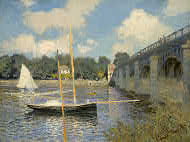
|
Claude Monet (artist) French, 1840 - 1926 The Bridge at Argenteuil, 1874 oil on canvas Overall: 60 x 79.7 cm (23 5/8 x 31 3/8 in.) framed: 78.1 x 97.8 x 4.7 cm (30 3/4 x 38 1/2 x 1 7/8 in.) Collection of Mr. and Mrs. Paul Mellon 1983.1.24 |
From a distance of ten feet or so, Monet’s brushstrokes blend to yield a convincing view of the Seine and the pleasure boats that drew tourists to Argenteuil. Up close, however, each dab of paint is distinct, and the scene dissolves into a mosaic of paint—brilliant, unblended tones of blue, red, green, yellow. In the water, quick, fluid skips of the brush mimic the lapping surface. In the trees, thicker paint is applied with denser, stubbier strokes. The figure in the sailboat is only a ghostly wash of dusty blue, and the women rowing nearby are indicated by mere shorthand.
In the early years of impressionism, Monet, Renoir, and others strove to capture the fleeting effects of light and atmosphere on the landscape and to transcribe directly and quickly their sensory experience of it. Monet advised the American artist Lilla Cabot Perry, “When you go out to paint, try to forget what objects you have before you, a tree, a house, a field or whatever. Merely think here is a little square of blue, here an oblong of pink, here a streak of yellow, and paint it just as it looks to you, the exact color and shape, until it gives your own naive impression of the scene before you.”


